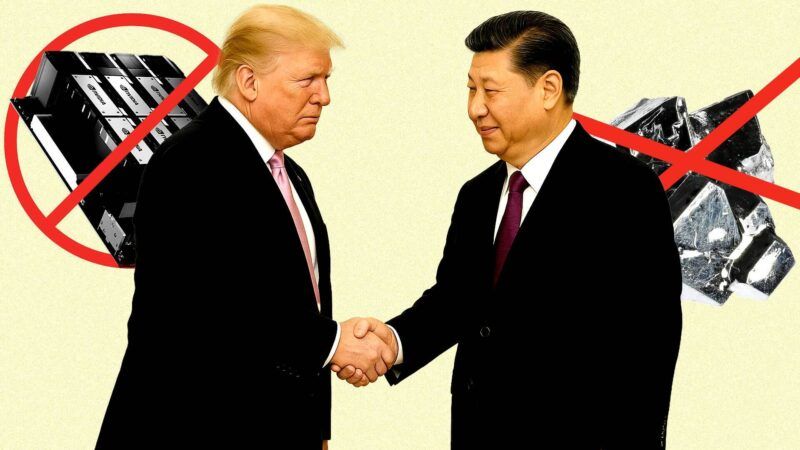Tariffs on Chinese Goods Drop to 55%, but That's Cold Comfort for Consumers
Triple-digit bilateral tariffs have been brought down to double digits. Negotiations on semiconductors and rare earth elements will continue.

The United States finalized a trade deal with China on Thursday that will see tariffs on Chinese imports fall to 55 percent (from 145 percent) and Chinese duties on American imports drop to 10 percent (from 125 percent). Though a reduction in tariffs is worth celebrating, the retention of American export controls on Chinese-bound semiconductors and China's maintenance of licensing for American-bound rare earth elements suggest that the struggle between the two nations is far from over.
The early-May Geneva Consensus reached by American and Chinese trade representatives in Switzerland broke down after China refused to roll back export restrictions on rare earth elements (REEs)—critical inputs for the production of semiconductors. About 90 percent of those critical inputs are produced in China. The Trump administration responded by announcing export controls on semiconductor design software and jet engines.
Following negotiations in London between Commerce Department Secretary Howard Lutnick and Chinese Commerce Minister Wang Wentao, President Donald Trump announced the reduction of American tariffs on Chinese goods and gave permission for Chinese students to continue studying at American universities. China reciprocated by decreasing its tariff on American exports and by removing export controls on REEs in what Lutnick called "a balanced way."
Trump described the American-Chinese relationship as "excellent," but American export controls on advanced semiconductors remain in place. Treasury Secretary Scott Bessent testified on Wednesday in a Senate appropriations subcommittee hearing that "there is no quid pro quo in terms of chips for rare earths." China's ministry of commerce is maintaining its examination and approval process on REEs, approving an unspecified number of licenses for export to the U.S.
The countries' tit-for-tat trade war, which is likely to continue under this agreement, has been raging since October 2022, when the U.S. Bureau of Industry and Security restricted China's "ability to both purchase and manufacture certain high-end chips." Since then, China has responded to American export controls on the high-end semiconductors used to train and run AI models by imposing export controls on the raw materials used to fabricate them, such as antimony, gallium, and germanium.
While 55 percent tariffs on Chinese goods is "better than the worst-case scenario we saw in April…it's still not good for importers in the United States," argues Scott Lincicome, vice president of general economics at the Cato Institute. Meanwhile, businesses and consumers have suffered from input-price volatility and higher prices, respectively. "The liberalization of China's export restrictions on rare earths…only lasts for six months," explains Lincicome. Ryan Young, an economist at the Competitive Enterprise Institute, argues that instead of trying to secure REEs through trade deals that could be easily renegotiated, lawmakers should remove self-imposed regulatory obstacles "like the conflict minerals provision of the Dodd-Frank Act." (That law imposes a range of requirements on American companies sourcing certain minerals from abroad.)
American tariffs on Chinese exports are still more than double what they were before Trump took office, according to data compiled by the Peterson Institute for International Economics. While Chinese tariffs on American exports have been successfully reduced to half of the levels seen under the Biden administration, Americans should expect China to leverage its dominance over rare earth elements to extract concessions from the U.S. in the future.




Show Comments (32)